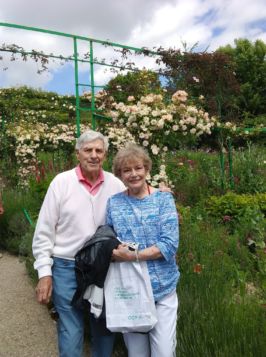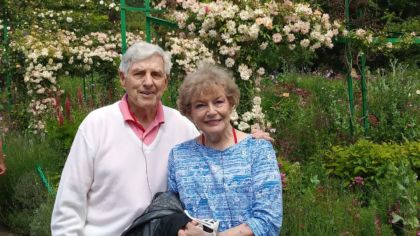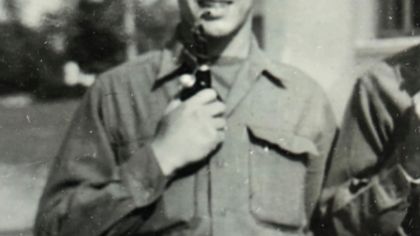Lincoln Harner
WORLD WAR II EXPERIENCE OF HARLAN LINCOLN HARNER
I entered the Army on April 7, 1943 at Fort Dix, New Jersey. I was 18 years old. Within a few weeks I was assigned to Fort Sill, Oklahoma, home of the artillery. After basic training I attended a 4-month radio course, then was assigned to the 987th Field Artillery Battalion at Camp Bowie, Texas. The 987th had 3 batteries, each with four 155 millimeter self-propelled guns that could move quickly. Including headquarters and service batteries, the battalion had about 600 men.
On D-Day, 1944, I was a Technician Fifth Grade (T/5) radio operator with B Battery of the 987th, part of the advance party needed on the first wave. Our unit was assigned to the British 50th Division for the invasion of Normandy.
We embarked early on June 5th, 1944 from Felixstowe on England’s North Sea coast on 4 LSTs and joined the numerous craft headed across the English Channel. Ours had a Canadian crew and we landed on the British Gold Beach near La Riviere about 7 pm June 6th, seven hours later than scheduled because of heavy seas. We remained on the beach overnight because the tide was too high to land our heavy guns. What a night it was as a British battleship and other naval craft exchanged fire with German shore batteries and drove off several enemy planes. On the morning of June 7th we went ashore and our first gun position was about 3 miles inland near Ryes. The rest of our battalion came ashore over the next few days. The main objective of the British and Canadians, and of course our battalion, was Caen, which was a vital road network. Caen was heavily defended by dug-in German armor and wasn’t liberated until July 20th. On June 30, with our unit at Bayeux, we rejoined the US First Army on our immediate right.
We were Fifth Corps artillery, and from then on supported numerous divisions during the European Campaigns — Normandy, Northern France, the Ardennes. Rhineland and Central Europe.
Highlights for our unit were D-Day, the St. Lo breakthrough, liberation of Paris, liberation of Luxembourg, Battle of the Bulge, battle of Hurtgen Forest, first heavy artillery to penetrate the Ziegfried Line, crossing of the Rhine at Remagen, the dash across Germany to the Elbe River , then south into Czechoslovakia, reassignment to General Patton’s 3rd Army, attachment of my B Battery to the 16 Armored Division on its first and only mission the liberation of Pilsen on May 7, and the celebration on VE-Day May 8, 1945.
During eleven months of combat, the 987th Field Artillery Battalion was attached to or supported three armies – the British 2nd under Dempsey, the US 1st under Bradley then Hodges, and Patton’s 3rd; two British divisions, and 18 American divisions — 12 infantry, one airborne and 5 armored. The battalion traveled some 1,850 miles, fired 45,058 rounds, many in direct fire missions, had 9 men killed and 74 wounded, and captured 256 enemy soldiers.
After the liberation, we spent two more months in Czechoslovakia and met some wonderful Czech people.


